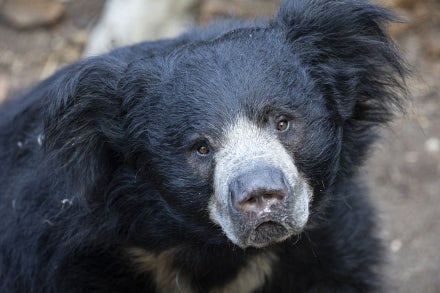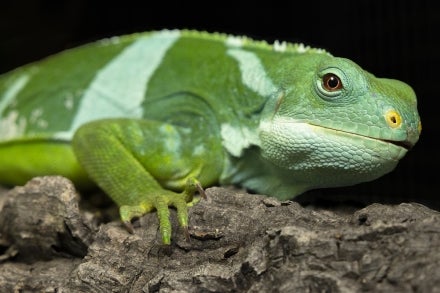Image

Wildlife “fashion” takes on many forms and hues—animals can wear even the flashiest colors with great aplomb. In celebration of autumn, let us behold a few species that flaunt some fiery shades of orange. The color symbolizes vitality and cheer—even as it serves as a cautionary tint for humans when used for life rafts, hunting attire, jailhouse jumpsuits, and road cones. Orange is a continuum of shades, from deep terra-cotta to pumpkin and mango, and fading into a mellow melon tinge. Animals don’t shy away from even the most garish version of orange!
[caption id="attachment_119716" align="aligncenter" width="1024"] ORANGE YOU GLAD YOU HAVE FUR?
ORANGE YOU GLAD YOU HAVE FUR?
Some primates are awash in fiery tones, like the orangutan (left) and golden lion tamarin (right), while the dazzling De Brazza’s monkey (middle) sports a flashy highlight of orange.[/caption] While many species sport brilliant orange accents, like the De Brazza’s monkey, others are immersed in the ginger tone, like the mighty orangutan and tiny golden lion tamarin. Although orange may appear vivid to us, many predators see in black and white or a limited color range, so orange becomes a shade of gray to them. Orange is particularly effective camouflage for forest dwellers: add some black stripes and you could walk right by a tiger without ever realizing its proximity. Add a few white stripes and that 500-pound bongo becomes invisible. Depending on the circumstances, orange manages to be both cryptic and a visual yell.






 ORANGE YOU GLAD YOU HAVE FUR?
ORANGE YOU GLAD YOU HAVE FUR?Some primates are awash in fiery tones, like the orangutan (left) and golden lion tamarin (right), while the dazzling De Brazza’s monkey (middle) sports a flashy highlight of orange.[/caption] While many species sport brilliant orange accents, like the De Brazza’s monkey, others are immersed in the ginger tone, like the mighty orangutan and tiny golden lion tamarin. Although orange may appear vivid to us, many predators see in black and white or a limited color range, so orange becomes a shade of gray to them. Orange is particularly effective camouflage for forest dwellers: add some black stripes and you could walk right by a tiger without ever realizing its proximity. Add a few white stripes and that 500-pound bongo becomes invisible. Depending on the circumstances, orange manages to be both cryptic and a visual yell.

Brilliant Babies
For some species, bright babies are more than something to brag about. Among the arboreal, highly social silvered leaf langurs of Southeast Asia, mothers allow other female monkeys to carry and care for their offspring. In stark contrast to the dark-coated adults, the youngsters are bright orange for the first three to five months of life—perhaps helping mum remember to retrieve her little one. Even the largest mammal in North America, the massive bison, is not taking any chances with its calves. The youngsters are a vibrant orange next to their chocolate-colored mommas, earning them the nickname “red dogs” of the plains. After a few months, when the characteristic shoulder hump and horns begin to come in, the calf's coat darkens, indicating impending adulthood.
The Colorful Panda
Though sharing its name with the iconic black-and-white bear, the cinnamon-colored red panda actually laid claim to the name first. French zoologist Frédéric Cuvier described this spicy little creature in 1825, classifying it as a close relative of the raccoon, but acknowledging its resemblance to felines with the genus name Ailurus, meaning “cat,” and species name fulgens, meaning “shining.” (He also rightfully proclaimed it one of the most beautiful creatures he’d ever seen!) This “shining cat” is not closely related to the giant panda—although both of these vegetarians are in the Order Carnivora. Confused yet? Some animals just defy categories!
Decked Out Duikers
Surely one of the best-dressed duikers (pronounced “dikers”) you’ll ever meet, the small, stocky red-flanked duiker of western and central Africa can afford to be diurnal, despite being potential prey. Its lush, red coat enables it to vanish into the forest, emitting a shrill bark and loud snort when threatened. This tiny antelope often follows foraging arboreal monkeys, feeding on the flowers, fruits, and vegetation they drop from the treetops. But if food is out of reach, the resourceful red-flanked duiker will stand upright on its hind legs to get it.
Lone “Wolf”
It’s a peculiar canid, and not just in looks. Though its bat-like ears, long, dark-colored legs, and flaming, fluffy fur are curious enough, add on a preference for fruit and a solitary lifestyle, and the maned wolf is truly a different breed! It is not actually a wolf, as it more closely resembles a fox on stilts, but it does sport a mane of long fur around its neck, chest, and back that can stand on end when a threatening situation arises. At home in the sprawling savannas of South America, this extraordinary creature relies on Solanum lycocarpum—also called the “wolf’s fruit”—to survive. It gets a well-rounded, omnivorous diet, devouring fruit, vegetables, and meat.
Hogging the Hue
There’s no mistaking a red river hog! Its bright, ruddy coat with a pokey white ridge down its spine, dramatic ear tassels, and long, wiry “guard hairs” around its face make this particular porcine a sight to behold. Social and vocal, these animals live in groups called “sounders” of about 6 to 15 individuals. Piglets are born with stripes on their bodies, which help to camouflage the perky piggies. Red river hogs have a great sense of smell, and they use their strong snouts to sniff out and dig up food sources. They use their sharp tusks for cutting through woody plants and tubers. These wild African pigs live up to their name, preferring habitat near rivers and swamps.
Snake Surprise
The secretive San Diego ring-necked snake might look like just another dark-colored reptile slithering by, except for its snappy orange-colored “necklace.” However, when the foot-long wonder is disturbed, it coils its tail like a corkscrew, revealing its bright orange underside, which may deter the threat. If that doesn’t work, it may also smear musk and cloacal contents (snake poop) on the interloper. Its venom is not dangerous to humans, but it does incapacitate small prey like lizards and frogs.




